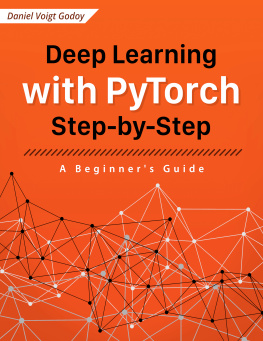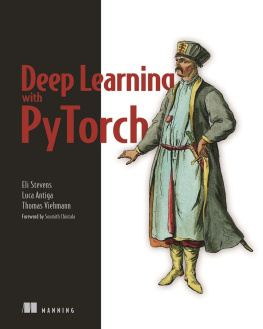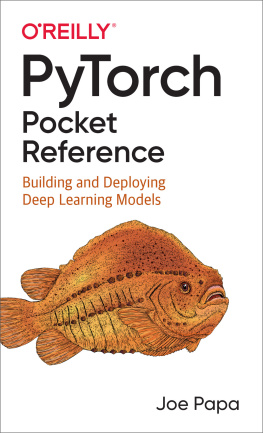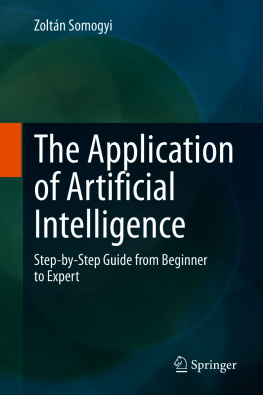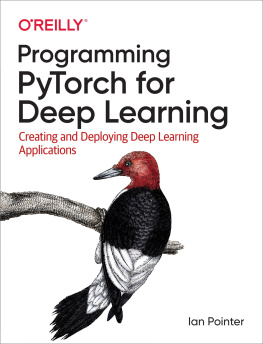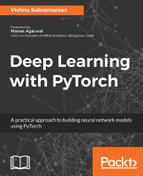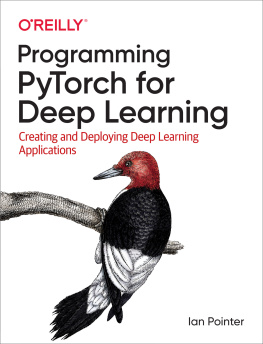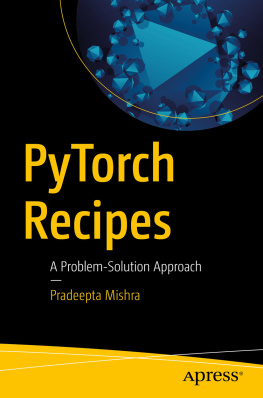Daniel Voigt Godoy - Deep Learning with PyTorch Step-by-Step: A Beginner’s Guide
Here you can read online Daniel Voigt Godoy - Deep Learning with PyTorch Step-by-Step: A Beginner’s Guide full text of the book (entire story) in english for free. Download pdf and epub, get meaning, cover and reviews about this ebook. year: 2021, publisher: leanpub.com, genre: Children. Description of the work, (preface) as well as reviews are available. Best literature library LitArk.com created for fans of good reading and offers a wide selection of genres:
Romance novel
Science fiction
Adventure
Detective
Science
History
Home and family
Prose
Art
Politics
Computer
Non-fiction
Religion
Business
Children
Humor
Choose a favorite category and find really read worthwhile books. Enjoy immersion in the world of imagination, feel the emotions of the characters or learn something new for yourself, make an fascinating discovery.
- Book:Deep Learning with PyTorch Step-by-Step: A Beginner’s Guide
- Author:
- Publisher:leanpub.com
- Genre:
- Year:2021
- Rating:5 / 5
- Favourites:Add to favourites
- Your mark:
- 100
- 1
- 2
- 3
- 4
- 5
Deep Learning with PyTorch Step-by-Step: A Beginner’s Guide: summary, description and annotation
We offer to read an annotation, description, summary or preface (depends on what the author of the book "Deep Learning with PyTorch Step-by-Step: A Beginner’s Guide" wrote himself). If you haven't found the necessary information about the book — write in the comments, we will try to find it.
Deep Learning with PyTorch Step-by-Step: A Beginner’s Guide — read online for free the complete book (whole text) full work
Below is the text of the book, divided by pages. System saving the place of the last page read, allows you to conveniently read the book "Deep Learning with PyTorch Step-by-Step: A Beginner’s Guide" online for free, without having to search again every time where you left off. Put a bookmark, and you can go to the page where you finished reading at any time.
Font size:
Interval:
Bookmark:
Deep Learning with PyTorch Step-by-Step: A Beginners Guide
by Daniel Voigt Godoy
Copyright 2020-2021 by Daniel Voigt Godoy. All rights reserved.
May 2021: First Edition
Revision History for the First Edition:
- 2021-05-18: v1.0
This book is for sale at
Although the author has used best efforts to ensure that the information and instructions contained in this book are accurate, under no circumstance shall the author be liable for any loss, damage, liability, or expense incurred or suffered as a consequence, directly or indirectly, of the use and/or application of any of the contents of this book. Any action you take upon the information on this book is strictly at your own risk. If any code samples or other technology this book contains or describes is subject to open source licenses or the intellectual property rights of others, it is your responsibility to ensure that your use thereof complies with such licenses and/or rights. The author does not have any control over and does not assume any responsibility for third-party websites or their content. All trademarks are the property of their respective owners. Screenshots are used for illustrative purposes only.
No part of this book may be reproduced or transmitted in any form or by any means (electronic, mechanical, photocopying, recording, or otherwise), or by any information storage and retrieval system without the prior written permission of the copyright owner, except where permitted by law. Please purchase only authorized electronic editions. Your support of the authors rights is appreciated.
"What I cannot create, I do not understand."
Richard P. Feynman
If youre reading this, I probably dont need to tell you that Deep Learning is amazing and PyTorch is cool, right?
But I will tell you, briefly, how this book came to be. In 2016, I started teaching a class on machine learning with Apache Spark and, a couple of years later, another class on the fundamentals of machine learning.
At some point, I tried to find a blog post that would visually explain, in a clear and concise manner, the concepts behind binary cross-entropy so that I could show it to my students. Since I could not find any that would fit my purpose, I decide to write one myself. Although I thought of it as a fairly basic topic, it turned out to be my most popular blog post! My readers have welcomed the simple, straightforward, and conversational way I used to explain the topic.
Then, in 2019, I used the same approach for writing another blog post: Understanding PyTorch with an example: a step-by-step tutorial. Once again, I was amazed by the reaction from the readers!
It was their positive feedback that motivated me to write this book to help beginners start their journey into Deep Learning and PyTorch. I hope you enjoy reading this book as much as I enjoyed writing it.
First and foremost, Id like to thank YOU, my reader, for making this book possible. If it werent for the amazing feedback I got from the thousands of readers of my blog post about PyTorch, I would have never mustered the strength to start and finish such a major undertaking as writing a 1,000-page book!
Id like to thank my good friends Jess Martnez-Blanco, (who managed to read absolutely everything that I wrote), Jakub Cieslik, Hannah Berscheid, Mihail Vieru, Ramona Theresa Steck, Mehdi Belayet Lincon, and Antnio Gis, for helping me out and dedicating a good chunk of their time to reading, proofing, and suggesting improvements to my drafts. Im forever grateful for your support! Id also like to thank my friend Jos Luis Lopez Pino for the initial push I needed to actually start writing this book.
Many thanks to my friends Jos Quesada and David Anderson, for taking me as a student at the Data Science Retreat in 2016 and, later on, for inviting me to be a teacher there. That was the starting point of my career both as a data scientist and a teacher.
Id also like to thank the PyTorch developers for developing such an amazing framework, and the teams from Leanpub and Towards Data Science for making it incredibly easy for content creators like me to share their work with the community.
Finally, Id like to thank my wife, Jerusa, for always being supportive throughout the entire writing of this book, and for taking the time to read every single page in it :-)

Daniel is a data scientist, developer, writer, and teacher. He has been teaching machine learning and distributed computing technologies at Data Science Retreat, the longest-running Berlin-based bootcamp, since 2016, helping more than 150 students advance their careers.
Daniel is also the main contributor of two Python packages: HandySpark and DeepReplay.
His professional background includes 20 years of experience working for companies in several industries: banking, government, fintech, retail, and mobility.
First, coding in PyTorch is fun :-) Really, there is something to it that makes it very enjoyable to write code in Some say it is because it is very pythonic, or maybe there is something else, who knows? I hope that, by the end of this book, you feel like that too!
Second, maybe there are even some unexpected benefits to your health - check Andrej Karpathys ] about it!
Jokes aside, PyTorch is the ] in academia already and it is making its way in the industry.
Several companies are already ], to name a few:
- Facebook: the company is the original developer of PyTorch, released in October 2016
- Tesla: watch Andrej Karpathy (AI Director at Tesla) speak about "how Tesla is using PyTorch to develop full self-driving capabilities for its vehicles" in ]
- OpenAI: in January 2020, OpenAI decided to standardize its deep learning framework on PyTorch (])
- fastai: fastai is a ]
- Uber: the company is a significant contributor to PyTorchs ecosystem, having developed libraries like ] (a distributed training framework)
- Airbnb: PyTorch sits at the core of the companys dialog assistant for customer service (])
This book aims to get you started with PyTorch while giving you a solid understanding of how it works.
There are so many PyTorch books and tutorials around, and its documentation is quite complete and extensive. So, why should you read this book?
First, this is not a typical book: most tutorials start with some nice and pretty image classification problem to illustrate how to use PyTorch. It may seem cool, but I believe it distracts you from the main goal: how PyTorch works? In this book, I present a structured, incremental, and from first principles approach to learn PyTorch.
Second, this is not a formal book in any way: I am writing this book as if I were having a conversation with you, the reader. I will ask you questions (and give you answers shortly afterward), and I will also make (silly) jokes
Next pageFont size:
Interval:
Bookmark:
Similar books «Deep Learning with PyTorch Step-by-Step: A Beginner’s Guide»
Look at similar books to Deep Learning with PyTorch Step-by-Step: A Beginner’s Guide. We have selected literature similar in name and meaning in the hope of providing readers with more options to find new, interesting, not yet read works.
Discussion, reviews of the book Deep Learning with PyTorch Step-by-Step: A Beginner’s Guide and just readers' own opinions. Leave your comments, write what you think about the work, its meaning or the main characters. Specify what exactly you liked and what you didn't like, and why you think so.

